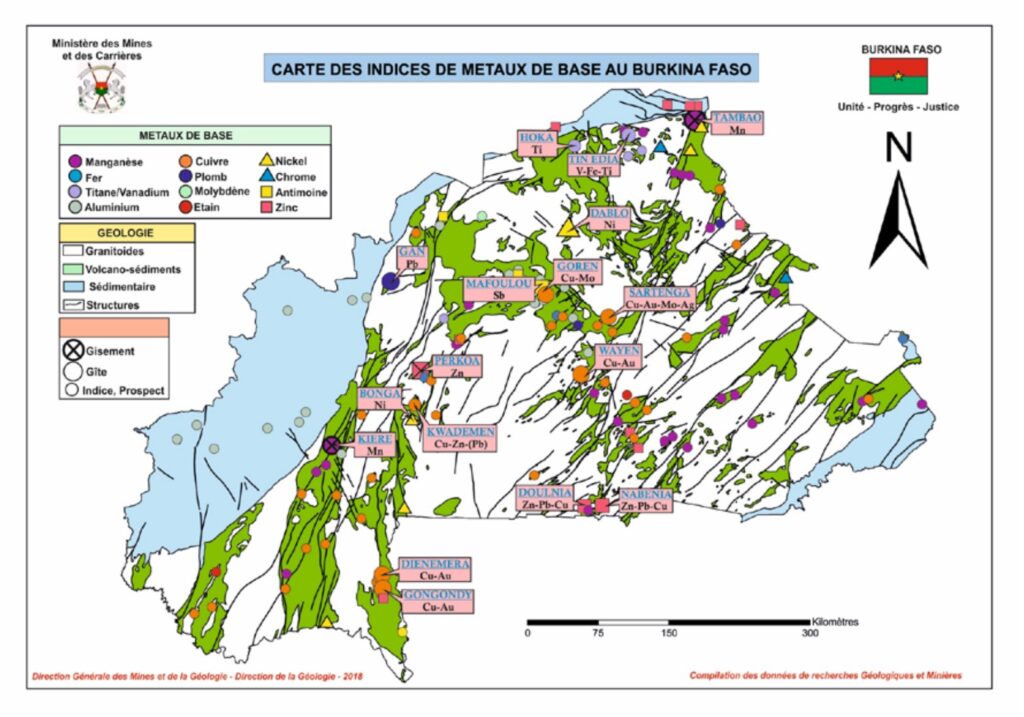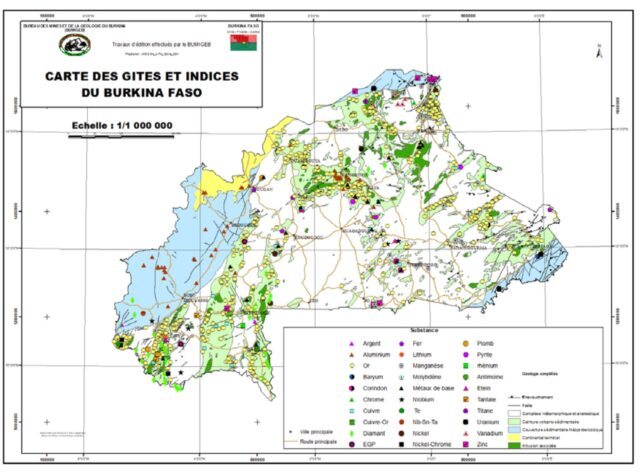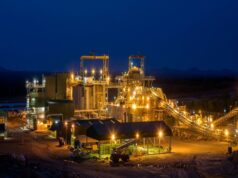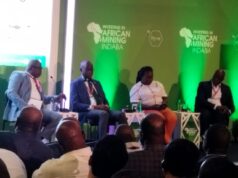In recent years, the extractive industry has played an increasingly important role in the country’s economy, contributing around 190 billion FCFA to the state budget in 2016 and 274.29 billion in 2019. Export revenues from mining products amounted to 1023 billion in 2016 and 1540 billion in 2018. Gold has been the country’s leading export since 2009. This is due to the country’s immense geological and mining potential.
Precious metals
Law 036-2015/CNT of 26 June 2015 on Burkina Faso’s mining code lists the following as precious metals: gold, silver, platinum and platinoids such as iridium, osmium, palladium, rhodium and ruthenium in their crude state, as well as any concentrate, residue or amalgam containing such metals. Gold and silver are the only precious metals mined in Burkina Faso. They are found in the birimian greenstone belts, which cover around 22% of the country. These include the Houndé, Boromo, Banfora, Loumana, Goren, Bouroum-Yalogo, Oudalan Goroual and Djibo furrows. There are sixteen (16) gold mines operating in the country, as well as semi-mechanised operations and many advanced projects (see attached table). In 2022, fine gold production is estimated at 57.674 tonnes and silver production at 7.328 tonnes. Most of this production will come from the mines at Essakane (Oudalan), Houndé (Tuy), Mana (Balé), Wahgnion (Léraba), Bissa (Namentenga), Boungou (Tapoa), Karma (Yatenga), Youga (Boulgou), Sanbrado (Ganzourgou) and recently the Bomboré project (Ganzourgou), which came on stream in the last trimester of 2022. All in all, from 2007 to 2022, more than 500 tonnes of fine gold have been extracted in Burkina Faso. In 2020, an analysis of the technical reports updating the gold reserves of the projects shows gold reserves of more than 600 tonnes for resources of more than 1,000 tonnes for all the projects already in place. Theoretically, if gold prices remain stable, this should keep Burkina Faso’s mining sector going for at least two (02) decades. Considering the twenty or so advanced projects with resource calculations, this should enable Burkina Faso to consolidate its position as a gold-producing country.
Ferrous metals
Burkina Faso has significant potential in ferrous metals. The largest of these are the Tambao manganese deposit (Oudalan), with a resource of around 107 million tonnes of manganese, and the Kiéré deposit (Mouhoun). In addition to manganese, the country is known for its nickel deposits, notably the lateritic nickel deposits at Bonga (Sanguié) and the EGP nickel deposits at Dablo (Sanmatenga), both of which are the subject of in-depth research by geological and mining research companies. As for ferrous metals, there are also iron-titanium-vanadium showings in Burkina Faso, with the largest resources in the Sahel region. These are the vanadiniferous magnetite deposits of Tin Edia and Gouba, whose resources are estimated at 45 million tonnes and 16 million tonnes of ore respectively, with an iron content of 35% and 0.7% vanadium. A number of unassessed showings have been found nearby. These include the Gountouwala, Kolel, Hoka and Pwiga showings. In the Sanmatenga region, similar mineralisation has been observed in the Ouga-Yarcé zone. It is distinguished by a combination of low-grade copper.
Non-ferrous metals
The non-ferrous metals found in Burkina Faso include zinc, copper, lead, antimony, aluminium and rare earths. While zinc is currently being mined, this is not the case for the other substances, where research is still ongoing. In Burkina Faso, the only non-gold mine is the Perkoa zinc mine (Sanguié), interpreted by some authors as being of the Volcanogenic Massive Sulphide (VMS) type. Production began in 2013, and after seven (07) years of operation was estimated at 6,900,000 tonnes in 2019, with a concentrate grade of around 50%. Similar mineral deposits have been identified in the Tiébélé area (Loubel, Nabénia and Koubongo showings) near Po, and at Kwademen (Sanguié), and are currently being developed through geological and mining research. Copper has a long history of research in Burkina Faso. Between 1931 and 1938, the Equatorial Mines Company (Compagnie Equatoriale des Mines – CEM) mined a 5,000-tonne copper lens at an average grade of 8% in the Gongondy prospect (Poni). Continued exploration in the area by successive mining companies has revealed a copper potential of nearly 973,661 tonnes, with associated gold resources of around 105.9 tonnes in the Gongondy and Diénéméra prospects. The same potential has been demonstrated at the Wayen, Goren and Sartenga prospects, where copper mineralisation is associated with molybdenite and silver in addition to gold. Most of these deposits have a low grade, offset by high tonnages. Mineralization of this type is very common in the geological context of Burkina Faso. Antimony and lead are often found together with other substances such as zinc, particularly in VMS-type mineralisation. This is the case, for example, in the Perkoa and Koubongo mineralisations, where lead is associated with zinc mineralisation. In addition to these associations, lead lenses have been found in the form of galena (PbS) in the Gan locality (Sourou), while the Mafoulou locality (Sanmatenga) is known for its antimony showings in the form of N-S oriented lenses of stibine (Sb2S3). Aluminium is fairly widespread in the country in the form of bauxite, particularly in the towns of Kaya, Kongoussi and Bobo Dioulasso, although it is not currently used in any economic concentrations. The same is true of rare earths, where showings have been found in Zoungou (Ganzourgou), Mangodara (Comoé) and Kangounadeni (Comoé) in association with columbite-tantalite.

Precious and semi-precious stones
In Burkina Faso, the search for precious stones has been limited to diamonds. Indications of diamonds have been found in the watersheds of the Mouhoun, Comoé, Léraba and Sissili rivers (Castaing et al., 2003). These are alluvial diamonds, the primary source of which has yet to be discovered. On the other hand, in the Barsalogho locality (Sanmatenga), primary showings of micro[1]diamonds were discovered in 1972 by the BGR and BUVOGMI in ultrabasic rocks of the meta-dunite and metaperidotite type. In addition to diamonds, brownish showings of centimetre-sized alluvial corundum have been observed at Matiakoali. At Kangouandeni (Comoé), greenish stony beryls were found in a muscovite pegmatite (Jonquet, 1962). To this should be added the centimetre-sized garnets associated with pegmatites found throughout the country. The same applies to spodumene (lithiniferous pyroxene), which appears in the form of centimetre-sized crystallisations in the pegmatites of TouoGodo (Ganzourgou). All these minerals may be semi-precious, but to date no studies have been carried out in this area. Non-metallic substances
Non-metallic substances include phosphates, carbonate materials, refractory clays and kaolin, siliceous sands and ornamental stones. Phosphate deposits represent the main mineral potential of the Volta Basin. Most of the country’s major deposits are found in this zone. These are the Arloub-djouma (Tapoa), Arly (Tapoa) and Kodjari deposits. The Kodjari deposit is the largest, with estimated reserves of 60 million tonnes at 27.5% P2O5. It is mined by the Burkina Phosphate Exploitation Company (Société d’Exploitation de Phosphate du Burkina – SEPB), which processes the phosphate into fertiliser for local farmers. Carbonate materials include limestone and dolomitic limestone. Large deposits of pure limestone with rare dolomitic intercalations are found in the Tin Hrassan (Oudalan) and Tin Dioulaf (Oudalan) areas, where a mining permit has been granted for open-cast mining as a mine material for cement manufacture. In the Bobo Dioulasso area, on the other hand, the limestone is dolomitic, and is found in the localities of Tiara, Samandéni, Koua, Dandé, etc. It is used in the manufacture of limestone. It is used to make lime. Kaolin and refractory clays are widespread in Burkina Faso. They are derived from the supergene alteration of Birimian or Neoproterozoic terrains. They are traditionally used for pottery and house building. Deposits that have been exploited include those at Tikaré (Namentenga), Titao (Loroum) and Koréba (Houet). Significant potential for silica sand has been identified in Borodougou (Houet), at the entrance to the town of Bobo Dioulasso. The BUMIGEB’s work has identified a potential of almost 370,000 tonnes, which is currently being mined in the traditional way. Ornamental stones include granite, laterite, feldspar, quartz, dolomitic limestone and tuff. These materials are used to make bricks, aggregates, tiles, etc. In 2019, around 535,022 tonnes of granite and 86,942 tonnes of tuff were mined for ornamental stone. An assessment of the potential is currently being carried out by the General Careers Department (Direction Générale des Carrières – DGC) in partnership with the Bureau of Mines and Geology of Burkina Faso (Bureau des Mines et de la Géologie du Burkina – BUMIGEB).
Energetic substances
Energetic substances are found in trace amounts in Burkina Faso. Indications of uranium have been revealed by geophysical work carried out by BUMIGEB. Studies are underway to confirm these indications. The presence of peat has also been reported in the Sourou river valley, while indications of hydrocarbons (oil, natural gas) are suspected in the Gondo plain, an area that shares the same geological context (Neoproterozoic to Cenozoic sediments covered by the terminal continental shelf) as the indications of hydrocarbons found in Mali and Mauritania.
This article was excerpted from the magazine Spécial #SAMAO2023
Download the entire magazine here: https://samao.org/magazine-samao-2023/?fbclid=IwAR1pfgfKbZMz2QBpOlu3fnnWzgAZE7ZOT4E_FZenV3YFXrn81cMaiRQWNas
#Mines_Actu_Burkina










